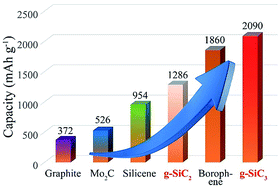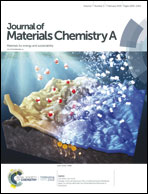Achieving high energy density for lithium-ion battery anodes by Si/C nanostructure design†
Abstract
Silicon (Si) is regarded as one of the most promising next-generation lithium-ion battery (LIB) anodes due to its exceptional capacity and suitable working voltage. However, dramatic volume expansion during charge/discharge processes and poor electrical conductivity cause severe detrimental consequences, greatly impeding the performance of Si-based LIB anodes. On the other hand, graphite, the widely used anode, possesses good stability and electrical conductivity; however, its low capacity of around 372 mA h g−1 is far from satisfactory. Herein, to combine the advantages of silicon- and carbon-based materials for anodes, we propose novel LIB anodes based on the concept of constructing Si/C composites. In this work, we find that emerging two-dimensional (2D) g-SiC2 and g-SiC3 (known as siligraphenes) could not only preserve the high capacity and low electrode voltage of silicon, but also inherit the good stability and electrical conductivity from graphite. The theoretical specific capacities of g-SiC2 and g-SiC3 are 1286 and 2090 mA h g−1, respectively, which exceed that of most of the 2D LIB anodes having a theoretical capacity below 2000 mA h g−1. Furthermore, g-SiC2 and g-SiC3 substrates can regain the planar structure after subsequent Li desorption. Because of the low voltage windows (g-SiC2: 0.55–0.3 V, g-SiC3: 0.65–0.33 V), g-SiC2 and g-SiC3 are promising candidates for high-energy-density LIB anodes. Advanced strategies to design high performance anodes are also discussed based on our understanding.



 Please wait while we load your content...
Please wait while we load your content...